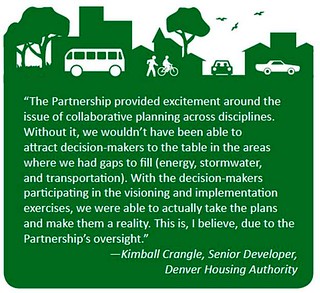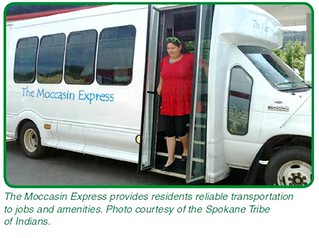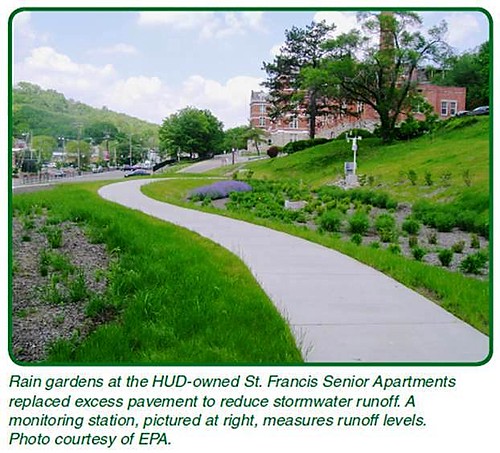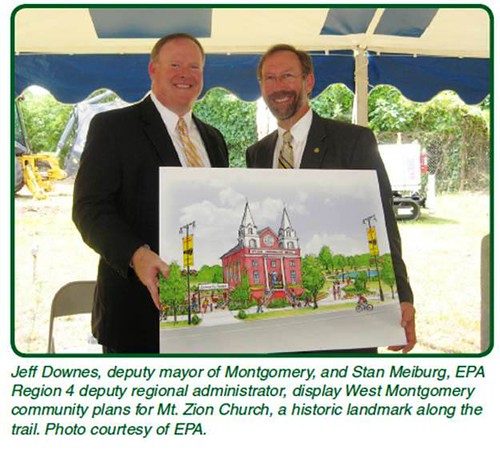How communities across America are creating a brighter future with help from the feds

Posted June 28, 2012 at 1:26PM
Three years ago, three federal agencies – the Department of Housing and Urban Development, the Department of Transportation, and the Environmental Protection Agency – announced that they were going to coordinate their community assistance programs to make them more effective in helping cities, towns and metropolitan regions position themselves for a more sustainable and resilient future. In some ways, this was a modest proclamation – an expression of common sense, really, since all three are part of the same government – except it had never happened before. In fact, there had been far too many examples where federal agencies were working at cross-purposes: EPA might be trying to help a community clean up a river, for example, at the same time as DOT or HUD might be funding projects that would send more sediment and polluted runoff into the river EPA was trying to clean up.
It would be naïve to say that, as a result of the agencies’ partnership, they no longer point communities in conflicting directions on occasion. But there has been no question that the Partnership for Sustainable Communities, as they call their joint effort, has had an incredible impact in empowering towns and cities to define and pursue their goals for a better future, with much more awareness of how issues interact with each other. And this has been done with no new mandates, with no pressure. This is not top-down coercion but responsiveness to local pleas for help with locally defined initiatives.
 I recently profiled one of the best neighborhood revitalization plans I have seen, for example, in the South Lincoln neighborhood of Denver. The city’s Housing Authority is rebuilding a badly distressed, low-income neighborhood with a mixed-income, mixed-use, highly walkable community -- with state-of-the-art green features, all adjacent to a light rail station – and it is doing so in a sophisticated, phased building schedule that will not displace a single resident. In fact, the residents are playing a major role in the process.
I recently profiled one of the best neighborhood revitalization plans I have seen, for example, in the South Lincoln neighborhood of Denver. The city’s Housing Authority is rebuilding a badly distressed, low-income neighborhood with a mixed-income, mixed-use, highly walkable community -- with state-of-the-art green features, all adjacent to a light rail station – and it is doing so in a sophisticated, phased building schedule that will not displace a single resident. In fact, the residents are playing a major role in the process.
The South Lincoln planning process has required a lot of difficult, painstaking work, but the Housing Authority didn’t have sufficient resources to do it all without help. In response to the city’s requests, the federal partnership stepped in and provided significant, coordinated grant assistance that made the process possible. The decisions have still been controlled locally, but with the support the locals needed to get it done.
In West Virginia, the three agencies coordinated to help the small cities of Ranson and Charles Town clean up contaminated sites, reconceive streets and stormwater management, and encourage walkable, in-town redevelopment, all at the same time.
Often only one of the three federal partners will provide funding assistance, but the three consult before grants are made, to take advantage of collective wisdom and keep each other informed. The Vital Signs community indicators project in Rockford, Illinois, for instance, has been undertaken with HUD assistance to help local planners identify ways they can measure progress toward locally determined goals.
In recognition of the three-year anniversary of the federal partnership’s formation, the three agencies have released a progress report, Three Years of Helping Communities Achieve Their Visions for Growth and Prosperity. The facts they have assembled are very, very impressive:
“Since 2009, the Partnership has provided over $3.5 billion in assistance to more than 700 communities. Partnership grant and technical assistance recipients are located in all 50 states, the District of Columbia, and Puerto Rico. Demand for Partnership assistance far outstrips available resources. As of April 2012, Partnership agencies received more than 7,700 applications for assistance, requesting almost $102 billion.”
Wow. The agencies have also launched a new joint website so the public can better access information about their activities and resources for community sustainability.
The report’s release comes on the heels of DOT’s announcement last week of the recipients of the agency’s “TIGER” (Transportation Investment Generating Economic Recovery) grants for 2012. The agency awarded nearly $500 million to 47 transportation projects in 34 states and the District of Columbia. Announcing the awards, Transportation Secretary Ray LaHood said, “TIGER projects mean good transportation jobs today and a stronger economic future for the nation.”
The community-oriented competitive grants will assist projects as diverse as these:
 Badly needed rail infrastructure improvements that will help air quality around the mammoth Hunts Point food market in the Bronx
Badly needed rail infrastructure improvements that will help air quality around the mammoth Hunts Point food market in the Bronx - Completion of a street network in tornado-damaged Birmingham, Alabama, to reconnect residents with transit hubs, schools, employment centers, recreational facilities, and historic Civil Rights destinations
- Improved bicycle and pedestrian access bus and rail transit in Houston
- Rebuilding the most heavily traveled road in a Chippewa community in North Dakota
- Transportation infrastructure for a major brownfield redevelopment in San Francisco
- Rehabilitating the nation’s seventh busiest passenger rail station in Sacramento
Even if TIGER were just a jobs program, it would be impressive. But DOT chooses projects that are multi-modal, multi-jurisdictional or otherwise challenging to fund through more traditional programs, using a rigorous process to select projects with exceptional benefits that make communities more livable and sustainable. TIGER applications are reviewed jointly by DOT, HUD and EPA.
 The partnership’s new report contains an impressive array of case studies in which the three agencies have cooperated. In Cincinnati, for example, EPA is funding research and pilot projects on how the city can use green infrastructure such as rain gardens, reforestation, and street and building upgrades to manage stormwater and clean up its polluted sewer system. DOT is using a TIGER grant to support the Cincinnati Streetcar. And a HUD-funded demonstration project will help encourage affordable housing and small-business entrepreneurship along the streetcar line. HUD is also supporting a number of other neighborhood improvement initiatives in the city, including changes to the zoning code that will remove obstacles to the application of green infrastructure to manage stormwater.
The partnership’s new report contains an impressive array of case studies in which the three agencies have cooperated. In Cincinnati, for example, EPA is funding research and pilot projects on how the city can use green infrastructure such as rain gardens, reforestation, and street and building upgrades to manage stormwater and clean up its polluted sewer system. DOT is using a TIGER grant to support the Cincinnati Streetcar. And a HUD-funded demonstration project will help encourage affordable housing and small-business entrepreneurship along the streetcar line. HUD is also supporting a number of other neighborhood improvement initiatives in the city, including changes to the zoning code that will remove obstacles to the application of green infrastructure to manage stormwater.
The South Lincoln and Ranson-Charles Town initiatives are among the case studies profiled in the impressive report. The report also highlights partnership-funded work along the historic Selma-to-Montgomery Civil Rights Trail, part of which I described here.
I could go on and on, but I have applauded the partnership before. For now, suffice it to say that I think it is the most impressive thing the federal government has done to help communities secure a better future since I first started paying attention. And they didn’t have to: this is all because of enlightened, creative leadership on the part of Secretaries Donovan and LaHood and Administrator Jackson, and their immensely talented staffs. Congratulations to them on three great years. Let’s hope it’s just the beginning.
Related posts:
- HUD launches Sustainable Communities Resource Center (February 16, 2012)
- How a small community is becoming greener - with help from some important friends (September 19, 2011)
- EPA announces "building blocks" for sustainability planning (February 4, 2011)
- A very impressive two weeks for the federal sustainability partnership (October 22, 2010)
- EPA joins exciting HUD/DOT partnership on sustainable communities (June 16, 2009)
- US Housing and Transportation Secretaries announce groundbreaking partnership for sustainable communities (March 19, 2009)
Move your cursor over the images for credit information.


